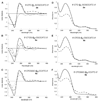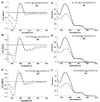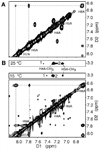Conformational differences of the C8-deoxyguanosine adduct of 2-amino-3-methylimidazo[4,5-f]quinoline (IQ) within the NarI recognition sequence
- PMID: 17311423
- PMCID: PMC2743555
- DOI: 10.1021/tx060229d
Conformational differences of the C8-deoxyguanosine adduct of 2-amino-3-methylimidazo[4,5-f]quinoline (IQ) within the NarI recognition sequence
Abstract
2-amino-3-methylimidazo[4,5-f]quinoline (IQ) is a highly mutagenic heterocyclic amine found in cooked meats. The major DNA adduct of IQ is at the C8-position of dGuo. We have previously reported the incorporation of the C8-IQ adduct into oligonucleotides, namely, the G1-position of codon 12 of the N-ras oncogene sequence (G1G2T) and the G3-position of the NarI recognition sequence (G1G2CG3CC) (Elmquist et al. (2004) J. Am. Chem. Soc. 126, 11189-11201). Ultraviolet spectroscopy and circular dichroism studies indicated that the conformation of the adduct in the two oligonucleotides was different, and they were assigned as groove-bound and base-displaced intercalated, respectively. The conformation of the latter was subsequently confirmed through NMR and restrained molecular dynamics studies (Wang et al. (2006) J. Am. Chem. Soc. 128, 10085-10095). We report here the incorporation of the C8-IQ adduct into the G1- and G2-positions of the NarI sequence. A complete analysis of the UV, CD, and NMR chemical shift data for the IQ protons are consistent with the IQ adduct adopting a minor groove-bound conformation at the G1- and G2-positions of the NarI sequence. To further correlate the spectroscopic data with the adduct conformation, the C8-aminofluorene (AF) adduct of dGuo was also incorporated into the NarI sequence; previous NMR studies demonstrated that the AF-modified oligonucleotides were in a sequence-dependent conformational exchange between major groove-bound and base-displaced intercalated conformations. The spectroscopic data for the IQ- and AF-modified oligonucleotides are compared. The sequence-dependent conformational preferences are likely to play a key role in the repair and mutagenicity of C8-arylamine adducts.
Figures




References
-
- Turesky RJ. Heterocyclic aromatic amine metabolism, DNA adduct formation, mutagenesis, and carcinogenesis. Drug Metab. Rev. 2002;34:625–650. - PubMed
-
- Schut HAJ, Snyderwine EG. DNA adducts of heterocyclic amine food mutagens: Implications for mutagenesis and carcinogenesis. Carcinogenesis. 1999;20:353–368. - PubMed
-
- Skog KI, Johansson MAE, Jagerstad MI. Carcinogenic heterocyclic amines in model systems and cooked foods: A review on formation, occurrence and intake. Food Chem. Toxicol. 1998;36:879–896. - PubMed
-
- Sugimura T. Overview of carcinogenic heterocyclic amines. Mutat. Res. 1997;376:211–219. - PubMed
Publication types
MeSH terms
Substances
Grants and funding
LinkOut - more resources
Full Text Sources
Miscellaneous

